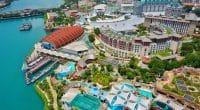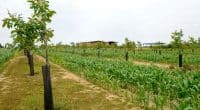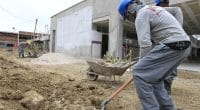At least 16 southern white rhinos have just been reintroduced into Garamba National Park in the Haut-Uele province of the Democratic Republic of Congo (DRC). The operation, which has so far been a success, was coordinated by the Congolese Institute for Nature Conservation (ICCN), African Parks and & Beyond, with financial support from the mining company Barrick Gold Corporation.
The future of the southern white rhino will also be decided in the Democratic Republic of Congo (DRC). The Central African country has just welcomed 16 individuals of this subspecies transferred from the & Beyond Phinda private reserve in the province of Kwa-Zulu Natal (KZN), South Africa. The pachyderms were flown to the airstrip of the Kibali gold mine in north-eastern DRC, before being transported by truck to Garamba National Park.
Barrick proudly celebrates the reintroduction of 16 white rhinos to Garamba National Park in the DRC. Thanks to our collaboration with @AfricanParks, @GarambaPark, @IccnRdc, and @andbeyondtravel, the rhinos were safely translocated. Learn more https://t.co/meMFZnJYDp pic.twitter.com/AlSLsYN5kS
— Barrick Gold Corporation (@BarrickGold) June 10, 2023
The operation was carried out as part of a partnership between the Congolese Institute for Nature Conservation (ICCN), the organisation in charge of conserving Garamba National Park, African Parks and & Beyond, with financial support from the mining company Barrick Gold Corporation, based in Toronto, Canada. “The return of white rhinos to the DRC is a testament to our country’s commitment to biodiversity conservation. The Garamba is on the verge of becoming a globally important sanctuary for megaherbivores, and the introduction of the southern white rhino into the country is an important step in advancing our contribution to rhino conservation in Africa,” says Milan Ngangay Yves, Director General of the ICCN.
The tragic fate of the northern white rhino
The southern white rhino has never evolved in Garamba National Park. It has replaced its cousin, the northern white rhino, whose last individual was poached in the park in 2006. This subspecies is now considered “functionally extinct”, as there are only two females left in Kenya’s Ol Pejeta nature reserve, but they are unable to reproduce.
Read also- DRC: action to dislodge M23 rebels from Virunga National Park
Although southern and northern white rhinos are closely related genetically, they live in very different habitats. In Garamba Park, the southern white rhinos will have to evolve in lush vegetation, surrounded by dense tropical forests. The 16 individuals transferred from South Africa are thus integrated into a biotope in which other large herbivores evolve, in particular Kordofan giraffes, whose species is in critical danger of extinction, and the largest population of elephants in the DRC.
Towards a new wave of reintroduction
“Efforts to save the northern white rhino have been too little, too late and should never be repeated. Now that Garamba is safe and adequately protected, this reintroduction is the start of a process by which the southern white rhino, the closest genetic alternative, can fill the northern white rhino’s role in the landscape,” explains Peter Fearnhead, Chief Executive of African Parks.
As well as giraffes and elephants, Garamba National Park is home to a large population of chimpanzees, as well as other large herbivores such as hippos, buffalo and hartebeest. These animals live alongside large predators such as lions and leopards. Over the next few years, African Parks plans to introduce more rhinos into the park, which has been on the United Nations Educational, Scientific and Cultural Organization (UNESCO) World Heritage List since 1980.
Jean Marie Takouleu







